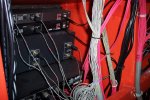famous beagle
Well-known member
I don't have a ton of equipment, but it's amazing how much those power cords can pile up! After a quick tally, I figure I have about 20 units to plug in, give or take a few maybe. I know it's best practice to keep audio cables and power cables separate, but that gets pretty hard to do. I've tried my best, but as I've added a few more things, it's gotten kind of messy back there again. So I'm looking to do an overhaul.
I was wondering how others handle this issue. Does anyone possibly have any pictures showing this?
I've basically been handling this so far by using 4 or 5 power strips all stemming from the same wall outlet.
I'm curious to see/hear others' solution.
Thanks!
I was wondering how others handle this issue. Does anyone possibly have any pictures showing this?
I've basically been handling this so far by using 4 or 5 power strips all stemming from the same wall outlet.
I'm curious to see/hear others' solution.
Thanks!



